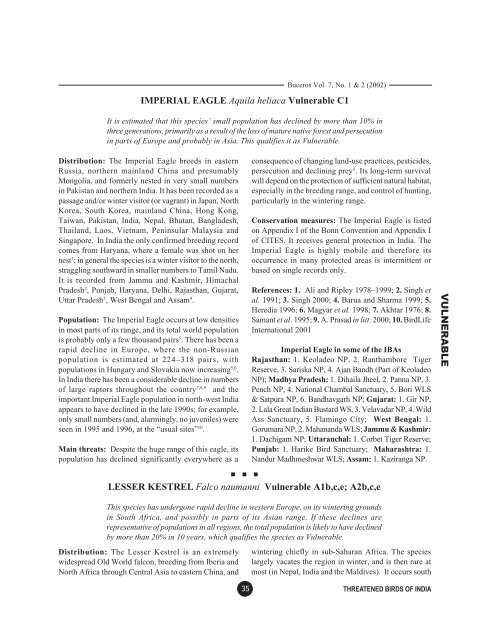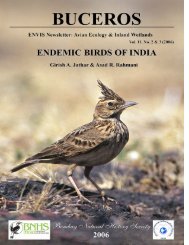Untitled - ENVIS Centre on Avian Ecology
Untitled - ENVIS Centre on Avian Ecology
Untitled - ENVIS Centre on Avian Ecology
Create successful ePaper yourself
Turn your PDF publications into a flip-book with our unique Google optimized e-Paper software.
Buceros Vol. 7, No. 1 & 2 (2002)<br />
IMPERIAL EAGLE Aquila heliaca Vulnerable C1<br />
It is estimated that this species’ small populati<strong>on</strong> has declined by more than 10% in<br />
three generati<strong>on</strong>s, primarily as a result of the loss of mature native forest and persecuti<strong>on</strong><br />
in parts of Europe and probably in Asia. This qualifies it as Vulnerable.<br />
Distributi<strong>on</strong>: The Imperial Eagle breeds in eastern<br />
Russia, northern mainland China and presumably<br />
M<strong>on</strong>golia, and formerly nested in very small numbers<br />
in Pakistan and northern India. It has been recorded as a<br />
passage and/or winter visitor (or vagrant) in Japan, North<br />
Korea, South Korea, mainland China, H<strong>on</strong>g K<strong>on</strong>g,<br />
Taiwan, Pakistan, India, Nepal, Bhutan, Bangladesh,<br />
Thailand, Laos, Vietnam, Peninsular Malaysia and<br />
Singapore. In India the <strong>on</strong>ly c<strong>on</strong>firmed breeding record<br />
comes from Haryana, where a female was shot <strong>on</strong> her<br />
nest 1 ; in general the species is a winter visitor to the north,<br />
straggling southward in smaller numbers to Tamil Nadu.<br />
It is recorded from Jammu and Kashmir, Himachal<br />
Pradesh 2 , Punjab, Haryana, Delhi, Rajasthan, Gujarat,<br />
Uttar Pradesh 3 , West Bengal and Assam 4 .<br />
Populati<strong>on</strong>: The Imperial Eagle occurs at low densities<br />
in most parts of its range, and its total world populati<strong>on</strong><br />
is probably <strong>on</strong>ly a few thousand pairs 5 . There has been a<br />
rapid decline in Europe, where the n<strong>on</strong>-Russian<br />
populati<strong>on</strong> is estimated at 224–318 pairs, with<br />
populati<strong>on</strong>s in Hungary and Slovakia now increasing 5,6 .<br />
In India there has been a c<strong>on</strong>siderable decline in numbers<br />
of large raptors throughout the country 7,8,9 and the<br />
important Imperial Eagle populati<strong>on</strong> in north-west India<br />
appears to have declined in the late 1990s; for example,<br />
<strong>on</strong>ly small numbers (and, alarmingly, no juveniles) were<br />
seen in 1995 and 1996, at the “usual sites” 10 .<br />
Main threats: Despite the huge range of this eagle, its<br />
populati<strong>on</strong> has declined significantly everywhere as a<br />
c<strong>on</strong>sequence of changing land-use practices, pesticides,<br />
persecuti<strong>on</strong> and declining prey 5 . Its l<strong>on</strong>g-term survival<br />
will depend <strong>on</strong> the protecti<strong>on</strong> of sufficient natural habitat,<br />
especially in the breeding range, and c<strong>on</strong>trol of hunting,<br />
particularly in the wintering range.<br />
C<strong>on</strong>servati<strong>on</strong> measures: The Imperial Eagle is listed<br />
<strong>on</strong> Appendix I of the B<strong>on</strong>n C<strong>on</strong>venti<strong>on</strong> and Appendix I<br />
of CITES. It receives general protecti<strong>on</strong> in India. The<br />
Imperial Eagle is highly mobile and therefore its<br />
occurrence in many protected areas is intermittent or<br />
based <strong>on</strong> single records <strong>on</strong>ly.<br />
References: 1. Ali and Ripley 1978–1999; 2. Singh et<br />
al. 1991; 3. Singh 2000; 4. Barua and Sharma 1999; 5.<br />
Heredia 1996; 6. Magyar et al. 1998; 7. Akhtar 1976; 8.<br />
Samant et al. 1995; 9. A. Prasad in litt. 2000; 10. BirdLife<br />
Internati<strong>on</strong>al 2001<br />
Imperial Eagle in some of the IBAs<br />
Rajasthan: 1. Keoladeo NP, 2. Ranthambore Tiger<br />
Reserve, 3. Sariska NP, 4. Ajan Bandh (Part of Keoladeo<br />
NP); Madhya Pradesh: 1. Dihaila Jheel, 2. Panna NP, 3.<br />
Pench NP, 4. Nati<strong>on</strong>al Chambal Sanctuary, 5. Bori WLS<br />
& Satpura NP, 6. Bandhavgarh NP; Gujarat: 1. Gir NP,<br />
2. Lala Great Indian Bustard WS, 3. Velavadar NP, 4. Wild<br />
Ass Sanctuary, 5. Flamingo City; West Bengal: 1.<br />
Gorumara NP, 2. Mahananda WLS; Jammu & Kashmir:<br />
1. Dachigam NP; Uttaranchal: 1. Corbet Tiger Reserve;<br />
Punjab: 1. Harike Bird Sanctuary; Maharashtra: 1.<br />
Nandur Madhmeshwar WLS; Assam: 1. Kaziranga NP.<br />
n n n<br />
LESSER KESTREL Falco naumanni Vulnerable A1b,c,e; A2b,c,e<br />
This species has underg<strong>on</strong>e rapid decline in western Europe, <strong>on</strong> its wintering grounds<br />
in South Africa, and possibly in parts of its Asian range. If these declines are<br />
representative of populati<strong>on</strong>s in all regi<strong>on</strong>s, the total populati<strong>on</strong> is likely to have declined<br />
by more than 20% in 10 years, which qualifies the species as Vulnerable.<br />
Distributi<strong>on</strong>: The Lesser Kestrel is an extremely<br />
widespread Old World falc<strong>on</strong>, breeding from Iberia and<br />
North Africa through Central Asia to eastern China, and<br />
wintering chiefly in sub-Saharan Africa. The species<br />
largely vacates the regi<strong>on</strong> in winter, and is then rare at<br />
most (in Nepal, India and the Maldives). It occurs south<br />
35 THREATENED BIRDS OF INDIA<br />
VULNERABLE




